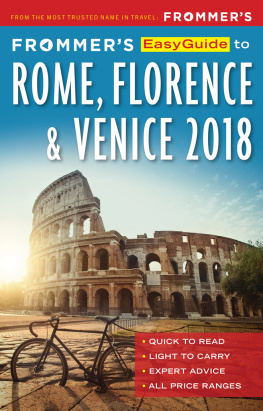101 Places in Italy




WILMINGTON SQUARE BOOKS
An imprint of Bitter Lemon Press
First published in 2014 by
Wilmington Square Books
47 Wilmington Square
London WC1X 0ET
www.bitterlemonpress.com
Copyright 2014 Francis Russell
All rights reserved. No part of this publication may be reproduced in any form or by any means without written permission of the publisher
The moral rights of the author have been asserted in accordance with the Copyright, Designs and Patents Act 1988
Some portions of this book were previously published in 52 Italian Places (Allemandi, 2007)
A CIP record for this book is available from the British Library
ISBN 978-1-908524-331
Designed and typeset by Jane Havell Associates
Index by Marianne Ryan
In memory of
Contessa Ester Bonacossa (190392),
who introduced me to so many
places and people in Italy

CONTENTS


THIS is an expanded, and I hope improved, edition of a book written in 2005 at the suggestion of Umberto Allemandi. The patterns of civilization lie more thickly upon the Italian peninsula than on any commensurate area of the earth. Successive civilizations have left their trace: Greek and Etruscan, Roman and Byzantine. Invaders have come and gone. But the peoples of Italy have shown an irrepressible artistic resilience unmatched elsewhere. England was in the van at certain moments. So, arguably more often, was France. Holland had its great century. But only of Italy can it be said that for three millennia no century or indeed generation has failed to leave its contribution, and that, with a consistency that can only humble the foreigner, so many strata of this creative achievement have determined the course of civilization throughout Europe.
Like anyone who revisits a country he loves, I am irresistibly drawn back to the places and works of art that aroused and have sustained that love. But I always try also to see sights that are new to me. In this respect Italy has proved and will always prove to be inexhaustible. Umberto asked for a selection of the fifty places that matter most to me; self-indulgence led me to raise the number to fifty-two. A hundred (and one) are included in this book. As will be obvious to the reader, my deepest interest lies in painting of the Italian Renaissance. The pursuit of this determined the course of my early sightseeing. But pictures and sculptures only make proper sense in the context of the buildings for which they were commissioned. They reflect the political and religious complexion of their cities and towns, which in turn must be seen in the context of their landscapes, the territory from which they drew their livelihood and upon which their strategic or economic importance depended.
Umberto charged me to be personal in the expression of my views. No sightseer is unprejudiced. I selected the places I myself would most have liked to revisit, and which, perhaps selfishly, I thus believed would give most pleasure to others. Where great towns are concerned, I outlined what I would choose to see again, the walks or perambulations I would take, the churches or museums in which I would linger. Buildings, however wonderful, that are not readily accessible to the public are omitted. It is not within the scope of this book to record opening hours of museums. But in Italy, churches open early and the traveller is advised to take advantage of this.
The selection was mine and involved many sacrifices. As I write I hear the advice of Ester Bonacossa, Etta to her English friends, when I was planning tours: dont forget Cividale; dont neglect Cefalu. In this expanded edition Cividale is one of four dozen additional places, many of obvious importance but others equally eloquent of the past, that ought to be better known. I have been more self-indulgent in my selection. Some of the omissions for which I was fairly taxed and indeed regretted myself have been made good. A number of smaller towns have been chosen, mostly because they can readily be visited in conjunction with more major centres, particularly in areas that offer most to the sightseer. Montesanto is here as a warning not to neglect opportunity.
But much, too much, more inevitably is still omitted: Aosta, Saluzzo and Ivrea in Piedmont; Vigevano, Lodi and Cremona in Lombardy; magical Torcello and unselfconcious Chioggia, Bassano, Fanzolo and Treviso in the Veneto; San Danieli del Friuli and Spilimbergo in Friuli; Modena, Faenza and Forl in Emilia-Romagna; and in Tuscany, long-prosperous Prato, Collodi, palace-lined Montepulciano and Massa Marittima. I have had to be equally ruthless in Umbria, forfeiting Spello, Todi, Amelia, Narni and Norcia, as well as Senigallia, Ancona and Recanati, Fabriano and Tolentino in the Marche, not to mention numerous remote early churches both there and in the Abruzzi. Nearer Rome, many interesting places, including Cervetri and Subiaco, are passed by. So further south are Sulmona, which I have not seen since the recent earthquake, Capua, SantAngelo in Formis and Herculaneum, as well as, in Basilicata, Altomonte, where the exquisite Simone Martini might not recompense every traveller for a long diversion. In Sicily Cefal is still an absentee, as are Catania, Agrigento both ancient and modern and Marsala.
Some sites are briefly touched upon in the entries for neighbouring places, and in a few instances, particularly in Sardinia, churches and other places that can be conveniently seen on brief journeys are linked. A few places, including Frascati and Ninfa, are absent because I have not visited these; while others, notably Taormina, are passed over for the irrational reason that these failed to come up to personal expectation. Those who want to explore are admirably served by the red guidebooks of the Italian Touring Club and that pocket-sized volume so indispensable to my early Italian sightseeing, the 1932 Oxford edition of Berensons Italian Pictures of the Renaissance.
Italy has changed since I came to know it in 1966, and continues to change. White oxen are no longer used to plough in Tuscany. Peasant farmers have left for the towns. Tracts of country have been suburbanized, whether by Italians or foreigners, their former farmhouses severed from the landscape by intrusive fencing. New building in many areas has been uncontrolled. So has the motor car. But prosperity has meant much that seemed in danger has been safeguarded; and just as the Italian authorities have long sought to restrain the export of works of art, so they have taken heroic steps to preserve a prodigious architectural inheritance. Despite valiant efforts to prove the contrary, many of the artistic achievements of twentieth-century Italy do not represent a natural or organic process of evolution. And I am certainly not qualified to write about these. While I would love to see again that enchanted room muraled by Severini for the Sitwells at Montegufoni, I cannot claim a strenuous appetite for Modigliani or Morandi. I have been more impressed by architecture of the Fascist period in Libya and Ethiopia than in Italy and do not intend to revisit Carlo Scarpas celebrated mausoleum at Riese, although I do admire Giancarlo dei Carlis cascading additions to the University of Urbino and his housing scheme near Terni. But it is not for such things that most tourists go to Italy.
Next page
















